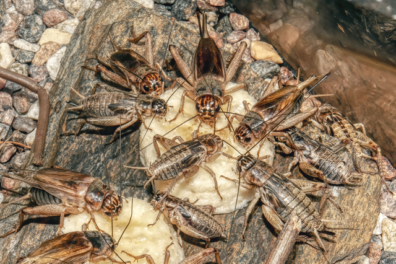Dear Carola,
Have you ever read the book “The Very Quiet Cricket?” It’s about a young cricket who can’t chirp until he grows up.
My friend Rich Zack reminded me of that book when we talked about your question. He’s an insect scientist at Washington State University.
He told me only adult male crickets make sound. Sometimes they chirp to defend their territories. It’s how they tell other male crickets to stay away.
But the main reason they chirp is to find a mate. Cricket chirps are mating songs. That song will be different for different kinds of crickets—and the song changes when the female cricket shows up.
“The male sings a very specific song for that species of cricket,” Zack said. “That attracts a female of that species to him. As she gets closer, and they start to recognize each other, he will vary that song a little bit. It’s a way to give the female assurance that he is the right species.”
So, why don’t female crickets chirp?
The way crickets make sound is called stridulation.
“All stridulation means is the insect is rubbing two things together,” Zack explained. “Crickets have what we call a file and scraper system.”
The file is a line of bumps on one of their wings. They look like pegs or the teeth of a comb. The scraper is the hardened edge of the other wing. The cricket rubs the file and scraper together to chirp. You could rub the teeth of a comb along a table edge to make a similar sound.
Female crickets don’t have a file or scraper on their wings. So, they can’t chirp.
They can hear the male cricket’s song, though. Crickets have hearing organs on their front legs. This organ is called a tympanum. It’s a stretchy membrane like your ear drum. Just like your ear drum, it vibrates when sounds hit it. Eventually those vibrations change into a signal that shoots up to your brain. That’s how you—and crickets—hear.

Crickets belong to the same insect group as grasshoppers and katydids. Those insects use stridulation, too. Katydids rub their wings together just like crickets. But grasshoppers have the file on their leg. So, they rub their leg against the scraper on their wing.
Remember how different kinds of crickets sing different songs? Zack told me you can tell different kinds of crickets just by listening to them.
“There are some rare crickets in Washington,” he said. “We would go out and try to find them. The way you do that is to listen for the songs. We could differentiate the songs, and then we would go search for that type of cricket. You can sit outside at night and differentiate cricket songs, too.”
When you listen to those crickets singing to each other in the dark, you can imagine all the young crickets listening to the songs and waiting for their turns to chirp.
Sincerely,
Dr. Universe